
A Berry Good Idea – July/August 2017, Canadian Packaging, updated
By Andrew Joseph, Features Editor; Photos by Naomi Hiltz
Automation Food Safety Bottling Case Packing Coding & Labeling Controls/Drives Conveying Corrugated Metal Detection Palletizing Plastic Robotics Arpac LLC Arrowhead Systems Inc. BW Container Systems Crofter’s Organic Domino Printing Sciences plc Elmar Industries Flexicon Corporation Hartness ITW KUKA Robotics Canada Ltd. L&A Process Systems Inc. Langguth America Ltd. Markem-Imaje Inc. Massily North America Inc. Mettler-Toledo Inc Moore Packaging Corporation Nordson Corporation Peco InspX Prosysco Ltd. Rockwell Automation North America Ryson International Inc. Siemens Canada Limited slideshow Storcan Limited Vantage Pak International Inc.Small-town Ontario producer kicks out the jams to make its mark in the North American markets with world-class product quality and cutting-edge packaging automation
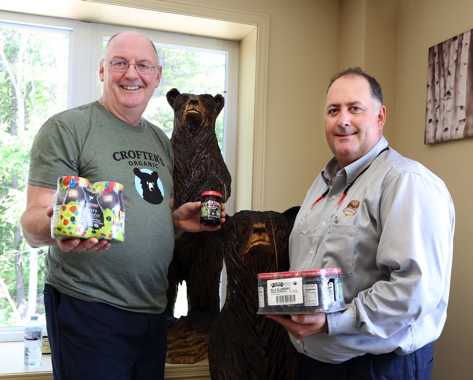
(From left): Crofter’s Organic co-owner Gerhard Latka and Arrowhead Systems product manager for case handling product Chris Cunningham hold samples of Crofter’s delicious organic spreads at the new, highly-automated facility in Seguin, Ont.
Up until very recently, the picturesque Northern Ontario cottage country town of Parry Sound could lay much of its international claim to fame at the skates of hockey legend Bobby Orr—thanks to the breathtaking skill and talent this home-grown superstar showed at a multitude of arena across North America jam-packed with adoring hockey fans during his illustrious career.
But small places like Parry Sound—a popular cottage town located some 250 kilometers north of Toronto in the UNESCO Georgian Bay Biosphere Reserve and boasting the world’s deepest natural freshwater port—can’t survive on past sporting glories alone.
Blessed with a thriving local tourism industry and virtually endless possibilities for year-round outdoor recreation, Parry Sound is also a fertile ground for progressive entrepreneurial companies like Crofter’s Organic, acknowledged as the leading manufacturer of organic fruit spreads and preserves in North America.
Started in 1989 by German immigrants Gabriele and Gerhard Latka, Crofter’s provides a compelling example that size is not everything when it comes to achieving success in the food processing business, especially in the fast-growing organics segment.
Currently employing 57 full-time people, the family-owned company has spent nearly $18 million in the past four years to not only modernize its existing Parry Sound production site, but also start up a second manufacturing plant in the neighboring community of Seguin Township.
Nearly 88 per cent of its manufactured output is exported to the U.S. market which continues to grow, and now the company’s products are exported to Germany with CETA (Comprehensive Economic Trade Agreement) and to Japan via the Canadian Organic Regime/Japan (JAS) equivalency.
According to the company’s hands-on owner Gerhard Latka, both plants house an extensive arsenal of high-performance production and packaging machinery designed and integrated to keep the jam manufacturer’s labor and other productions costs at highly competitive levels.
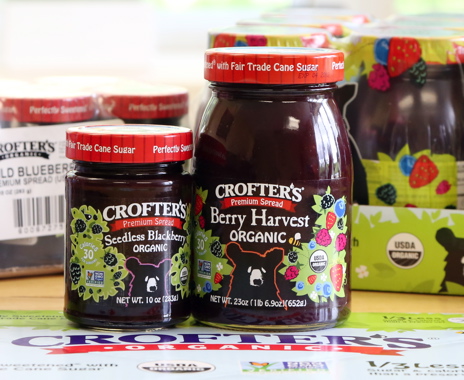
Available in various jar sizes, Crofter’s has three different product lines and 26 flavor profiles of certified organic jams, preserves and spreads. The jars in the foreground, and in the jars in the right background, sit atop and within corrugated trays manufactured by Moore Packaging Corporation.
“We moved into the newer Seguin facility two years ago, but we decided to keep the older one in Parry Sound as well, for our smaller private label customers, and as a redundancy backup.”
Combined, both plants ad up to a total of over 70,000 square feet of production space.
“The Parry Sound facility runs at a rate of about 110 containers per minute,” reveals Latka, “while the newer Seguin plant can reach speeds of up to 250 units per minute. It can also handle larger jars up to 32-ounces.”
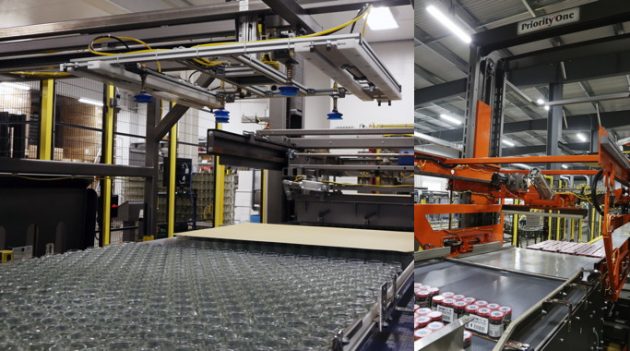
Crofter’s purchased a Priority One/Busse Xodus low-level bulk depalletizing system (above left) and a Priority One/Busse palletizer (above right) from leading packaging machinery supplier Arrowhead Systems, Inc. of Waterloo, Ont., who helped to integrate not only these two machines, but all the other key pieces of production equipment at the company’s new facility in Seguin.
The production lines at both facilities are fully-automated, explains Latka, with very little human interaction required outside of machine operation.
While the company had to rely mostly on locally-grown crops back in the early days to make its jams, preserves and fruit spreads, “Today Crofter’s operates a global supply chain to purchase ingredients from around the world,” notes Latka.
“That said, we still exclusively use organic wild blueberries sourced from the Quebec Wild Blueberries co-op, located in the heart of the boreal forest north of Quebec City,” says Latka, noting that 100 percent of the products it makes are certified organic, sweetened with either “fair trade”-certified organic sugar or organic white grape juice concentrate as an alternative sweetener, and typically containing one-third less sugar than most of the conventionally mass-produced brand-name jams out in the market.
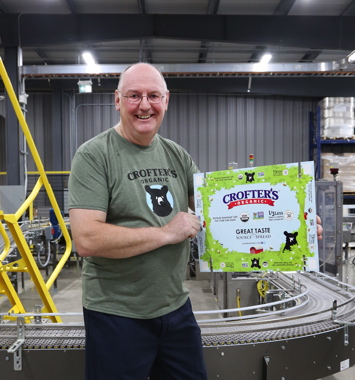
Crofter’s Organic co-owner Gerhard Latka holds up an example of a corrugated flat produced by Barrie, Ont.-based Moore Packaging Corporation.
The company’s expansive product portfolio comprises:
- The Premium Spreads line, sweetened by organic fair-trade cane sugar, consisting of Apricot, Berry Harvest, Concord Grape, Four Fruit, Mango, Morello Cherry, Pomegranate, Seedless Blackberry, Seedless Raspberry, Strawberry, Wild Blueberry, Biodynamic Apricot, Biodynamic Blueberry, and Biodynamic Strawberry flavors;
- The company’s Just Fruit Spreads line of premium-quality, fruit-juice sweetened-spreads in Apricot, Black Currant, Blackberry, Raspberry, Seville Orange, Strawberry, Superfruit, and Wild Blueberry flavors.
- The high-end Superfruit Spreads line named after four different continents—Asia, Europe, North America, and South America—sweetened with fair-trade cane sugar and incorporating 10 so-called “superfruits” high in antioxidants derived from the respective geographic regions.
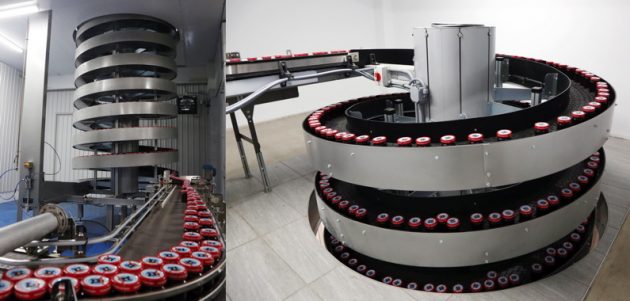
After going through a bottling and pasteurization process in the lower level of the Crofter’s Seguin-based facility (left), jars move along a Ryson spiral conveyor system to the upper floor for coding, labeling and secondary and end-of-line package processing.
According to Latka, the Premium Spread product line is currently Crofter’s bestselling line, especially the 16-ounce containers, while strawberry remains the most popular flavor.
“When we first started up this business, we only created our own Crofter’s branded products,” says Latka, “but having developed a very significant organic private-label program has helped us gain further recognition in both Canada and the U.S.”
Says Latka: “We currently operate one 10-hour shift every weekday.
“But thanks to the high efficiency of our new production facility here in Seguin, we have more tripled our capacity, while still maintaining a single-shift operation.”
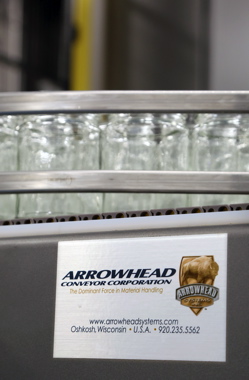
Arrowhead conveyors form the focal point of product movement at the Crofter’s facility, quickly and quietly moving product from the opening fill to the end-of-line.
To help the Seguin plant hit the ground running smoothly from the get-go, Latka sought out the expert advice of Chris Cunningham, product manager for case handling product at the Wisconsin-based packaging machinery group Arrowhead Systems, Inc.
Well-known for its expertise in conveyor systems integration and fully-automatic end-of-line packaging equipment, Arrowhead immediately proceed to design, commission and integrate a range of ‘best-inbreed’ packaging machinery and equipment that ultimately helped Crofter’s to triple its weekly output to three million cases per week.
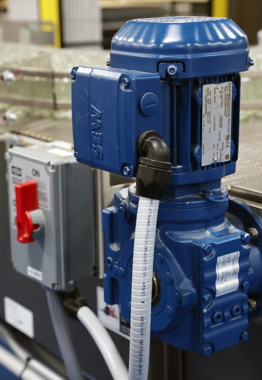
After the glass jars have been depalletized, a SEW-Eurodrive motor provides the power to the Arrowhead conveyor system at the Crofter’s facility.
The comprehensive range of the newly-installed equipment includes:
- Custom fruit and sweetener processing area with Flexicon bulk sugar dispensing system;
- Two 2,500-kilogram L&A pre-cookers;
- Three 2,500-kg L&A rotary coil vacuum cookers;
- Six Prosysco double-jacket 1,000-kg vacuum pans;
- Custom PLC/HMI automation control system;
- Inline rare-earth magnets;
- Arrowhead Systems’ Priority1/Busse depalletizer, and a palletizer system;
- Storcan elevator and inverter;
- Elmar 14-head piston filler;
- Massily steam capper;
- Mettler-Toledo metal detector unit and a Hi-Speed CM9400 Canweigh checkweigher—the Canweigh provides high-precision checkweigh solutions for round containers at high production line speeds thanks to its patented seam-to-seam weighing technology;
- I+H (now part of BW Container Systems) pasteurization/cooling tunnel;
- Ryson spiral elevator;
- Dynac first-in-first-out accumulation table from Hartness, an ITW Company;
- Peco dud detector;
- Mettler-Toledo weight checker;
- Langguth E40 inline full paper wrap labeler and E65 rotary self-adhesive three-station labeler;
- Domino laser coder for QR (quick response) code printing on unit label, and multiple QR capable case label printers;
- Domino and Markem-Imaje inkjet coders;
- Arpac 12-pack tray, six-pack pad, and two-pack unsupported bundler, and a pallet stretch wrapper;
- Secondary Vantage Pak tray packer for two-pack bundles at line speed;
- Kuka robotic pallet picking arm;
- Merv 15-rated air quality in cleanrooms. The higher the value—with 16 being the highest—the fewer dust particles and other contaminants pass through.
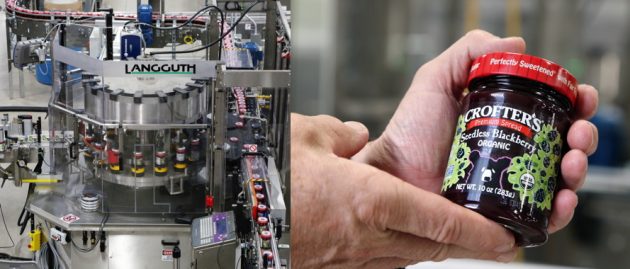
A Langguth E65 pressure-sensitive labeler applying front and back labels to filled and sealed Crofter’s jars at speeds up to 300 containers per minute.
According to Langguth, its E65 pressure-sensitive labeler machines are offered with Rockwell Automation’s Allen-Bradley or Siemens controls, and can include fully-automatic speed control in relation to upstream/downstream container flow. Depending on label length and number of labels on the container, a speed of up to 500 containers per minute is available.
The Langguth hotLAN 310 hot-melt labeler offers Crofter’s a full wrap labeling on round containers, utilizing a Nordson hotmelt adhesive completely closed system with no return glue and no chance of the glue being contaminated and no tarring of the tank. The hotLAN 310 is available with all the options offered with the E65.
“When we thought about all the equipment we wanted in this new facility, we were puzzled as to how we were going to lay it out, but Chris and his Arrowhead team came in with full confidence and put all of our fears to rest,” Latka recalls.
“They worked from Day One to help make the installation a success,” Latka adds, citing the seamless integration of the Xodus model low-level bulk depalletizer that quickly and safely moves tiers of glass jars onto the accumulation table, before they are conveyed single-file to the filling room.
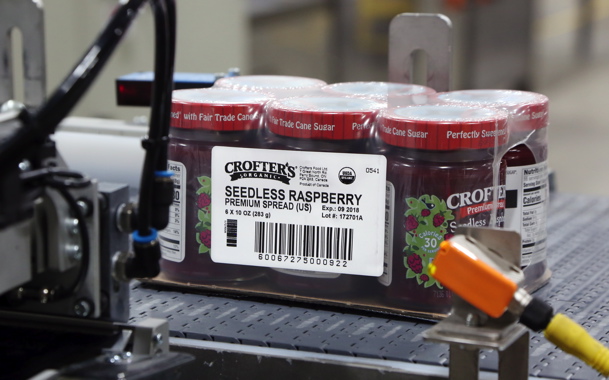
A Domino multiple QR-capable case label applicating system is used by Crofter’s to apply a wide range of product identification onto a six-pack of Crofter’s Seedless Raspberry Premium Spreads.
Built by the Busse/S.J.I. division of Arrowhead, the Xodus depalletizer comes standard, according to Cunningham, with Category 3 safety features such as interlock safety doors, muted light curtains on the entry and discharge areas.
“Any attempt at entry trying to bypass the light curtains will stop the machine,” says Cunningham, adding that a high-speed Xodus can depalletize approximately four layers of jars per minute.
After the glass jars pass through the Storcan inverter/sterilizer, they are transferred to the production area for precision filling, executed by the Elmar 14-head piston filler and a Massily steam capper, after which they are conveyed to the post-pasteurization
and cooling tunnel.
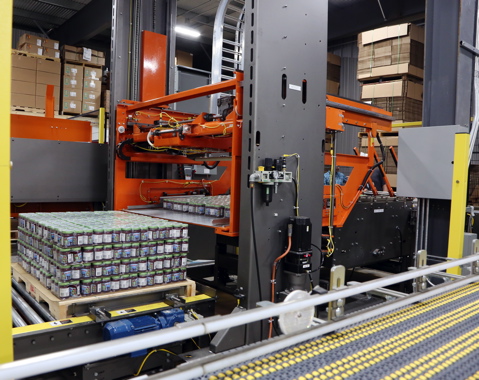
Crofter’s uses a Priority One palletizing systems purchased from Arrowhead to stack levels of jam jars, featuring safety guard rails and conveyor by Regal Beloit.
From there, the filled and sealed jars are elevated on a Ryson spiral elevator to the upper production floor area to pass through either of the two Langguth labelers (full wrap paper, or pressure-sensitive self-adhesive labels front and back).
The pressure-sensitive labeler is equipped with a Domino laser system for printing the QR code on the backside of each jar at a line speed of 250 jars per minute.
“We are probably one of the first companies in the food business to be able to print the QR code with a Domino laser system directly onto the backside of the jar’s label,” Latka notes.
“For us, the QR code offers a way to trace the product all the way back through our process,” he explains, “but it also enables the consumer to check on the production status of the product by scanning the code with a smartphone, and automatically linking it to our web page in case of a product recall or any concerns they might have about the product.”
The labeled jars are then packed in either two-, six- or 12-packs, which are then passed through a short heat-tunnel to apply a tight layer of shrinkwrap to keep the multipacks together, with a corrugated pad used as a base for the larger-sized sixpack bundles and 12-pack trays for extra support.
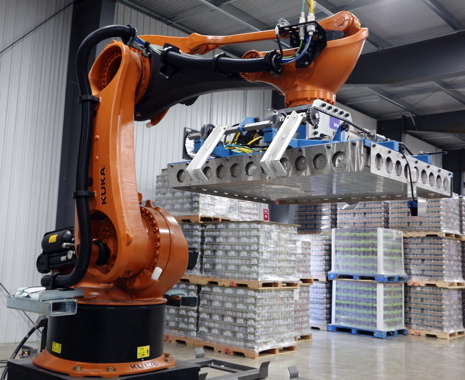
A large KUKA Robotics KR 700 PA robotic palletizing system is used by Crofter’s to build up mixed product pallet loads via a rare earth magnet to pick up layers from surrounding pallets one at a time.
“For club pack customers we also provide the option of packing six two-packs of jam into 12-pack trays,” notes Latka.
The six-packs and 12-pack trays then have case labels applied by twin Domino case label printers with pack information for distributors, including scannable barcodes and QR codes for full traceability and automated order picking.
Applying a QR code onto single jars running at a line speed of 250 jars per minute was an engineering accomplishment, according to Latka, that has allowed the plant to employ a special Kuka Robotics KR 700 PA robotic palletizing robot system to build mixed loads of products while sustaining 100 per cent traceability.
“It uses a rare earth magnet to safely pick up the layers one at a time to build the mixed-load pallet,” explains Cunningham.
“We also add QR codes onto the case labels and on the pallet tag—the latter of which we use with our Kuka Robotics palletizing system to prevent any miss-picks,” relates Latka.
“We wouldn’t want to send any Canadian products to the U.S., for example, and the QR codes help ensure we only ship what we are supposed to ship to where it is supposed to be shipped.”
Like most leading food processors, the Crofter’s plant follow a strict HACCP (Hazard Analysis Critical Control Points) food safety regime protocol, and in 2011 achieved the globally-recognized SQF Level 2 certification of the Safe Quality Food Institute (SQF).
Says Latka, “We are constantly taking steps to improve our company from an operational perspective, including adding top-flight automation equipment or by constructing a custom GE wastewater treatment facility.”
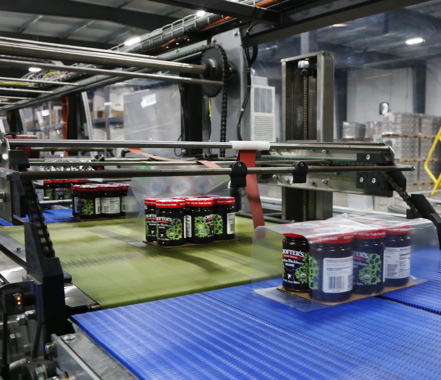
After six-packs of filled and sealed product have a corrugated pad placed under it and have a plastic sheet placed over it, it moves through an Arpac Eco-Tunnel shrink tunnel (below) to shrinkwrap the Crofter’s product.
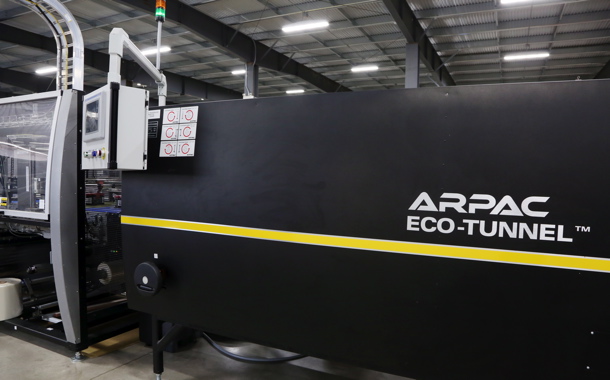 According to Latka, the new plant is far more sustainable and energy-efficient than the older Parry Sound facility.
According to Latka, the new plant is far more sustainable and energy-efficient than the older Parry Sound facility.
“Our new vacuum kettles are highly energy efficient, with rotary coils heating the fruit mass from the inside,” he explains.
“And because the new plant distributes the fruit mass by gravity, we engineered the new buildings to create a 15-foot drop from the release valve of the L&A vacuum kettles to the entrance valve of the filler bowl,” he says.
“There is no pumping required to transfer the fruit mass, allowing for better fruit piecing.”
Most of the plant’s daytime energy requirements are supplied via a 530 kWh natural gas generator, a reliable source of low cost energy for the rural plant, and a source of free heat energy. Two million BTU/hour of heat is generated when it is running, and if not captured would be lost into the environment. This free source of energy does not go to waste.
A connected heat exchange system transfers the generator heat into a water loop that circulates through the plant where the recovered heat is used to supply the kettles and pasteurizer with production energy, provide in-floor heat to the plant, warehouse and offices, and provide other users with heated water as needed.
The system is so efficient that heating boilers in the plant function as back-up heat sources that basically never comes on, other than on the coldest Northern Ontario winter nights.
At night when there is no production, the plant uses Ontario Hydro’s reduced night rates to power the plant.
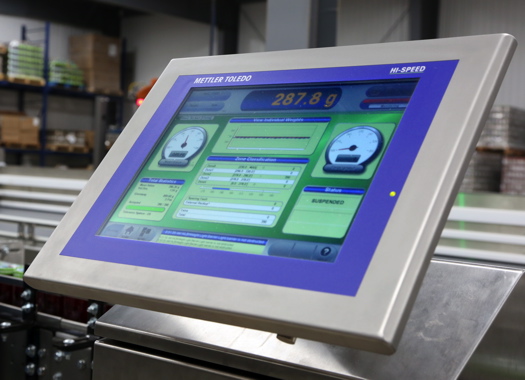
A Mettler-Toledo Hi-Speed CM9400 Canweigh checkweigher ensures proper jar fill levels.
The process of making jam requires high amounts of energy because the fruit mass must be pasteurized to 90C, and after hot-filling the jars and capping them, it passes through an extra pasteurization process where the jars are sprinkled with hot (92C) water in a heat tunnel. Within minutes, the 90C jars must be cooled to 40C.
To accomplish this, a 300,000 liter closed-return cooling water system sprinkles 20C water over the jars as they pass through a cooling tunnel.
The cool water picks up the heat from the jars, which raises the temperature of the cooling water to 35-40C.
“Our trick is how to cool the water back down to 20C without the use of an energy consuming cooling unit, so after cooling the jars, the now-warm water is run through a heat exchange system around miles of piping under the floors and outside into the earth where the heat in the water is exchanged into the cooler grown to keep loading ramps and parking areas snow and ice-free in the winter,” Latka explains.
“During the summer, loops located deeper in the ground cool the water back down to the 20°C temperature.
“There is no additional energy consumed to operate our cooling units,” says Latka, adding that unlike most food processors, the new Crofter’s plant is not hooked up to the local municipal water supply—operating its own 270-foot-deep well instead.
“Whereas our old plant would use up to 50,000 liters of municipal water per day ho handle an output of one million cases,” Latka remarks, “we currently consume about 25,000 liters of water a day to produce three million cases, conserving water and protecting our well.”
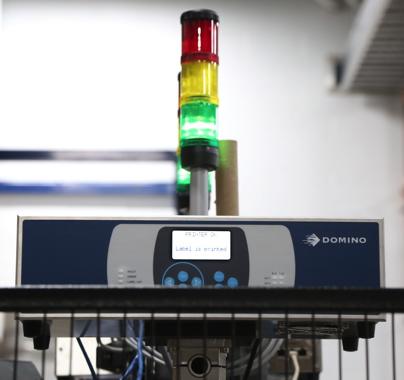
A Domino laser coder tracking the printed QR code applied to a Crofter’s product label.
Moreover, Latka says that Crofter’s recycles 95 per cent of its wastewater to clean its facilities, with the remainder disposed of through a licensed waste operator, or in the future as biosolids in agriculture.
According to Latka, sustainability is always a key consideration in the way the company goes about its daily business.
“We know that land fertility is always an ongoing concern in our business,” says Latka “and to help ensure our growing lands maintain its fertile growth Crofter’s has formed long-term relationship with our framers globally to ensure that the high-quality ingredients we us to create our great tasting spreads and jams are grown and always produced in an environmentally sustainable and socially-responsible way.”
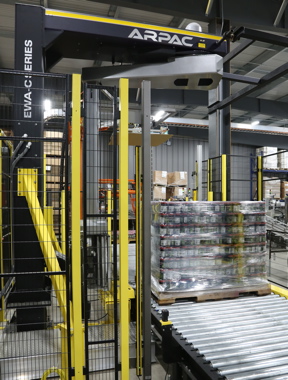
An Arpac EWA-C Series electro-wrap inline conveyorized automatic rotary tower quickly and quietly wraps a protective film around a pallet of Crofter’s product.
Combined with the new leading-edge production line integrated by Arrowhead, Latka is naturally upbeat about his company’s future growth prospects and potential.
“Initially we contacted Arrowhead for the purpose of purchasing a depalletizer and a palletizer,” he sums up, “but they were so proficient and thoughtful in designing how we could build our production line, that we used them to complete the entire project.
“Thanks to Arrowhead and their integration engineering, Crofter’s now has a state-of-the-art production process that has not only enable us to become more functional, but more importantly to become a better business.”
Please see an online video of the Arrowhead machinery line integration at Crofter’s Organic on Canadian Packaging TV at www.canadianpackaging.com
provides
Advertisement

